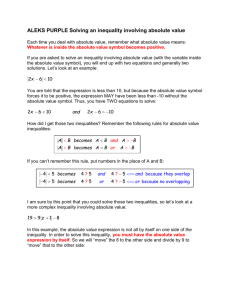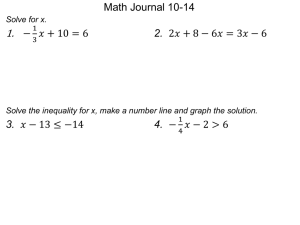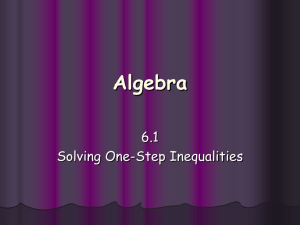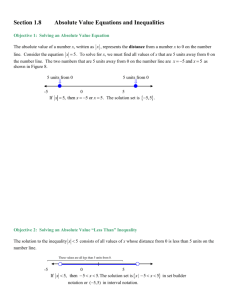5-2 : Solving Inequalities by Multiplication and Division
advertisement
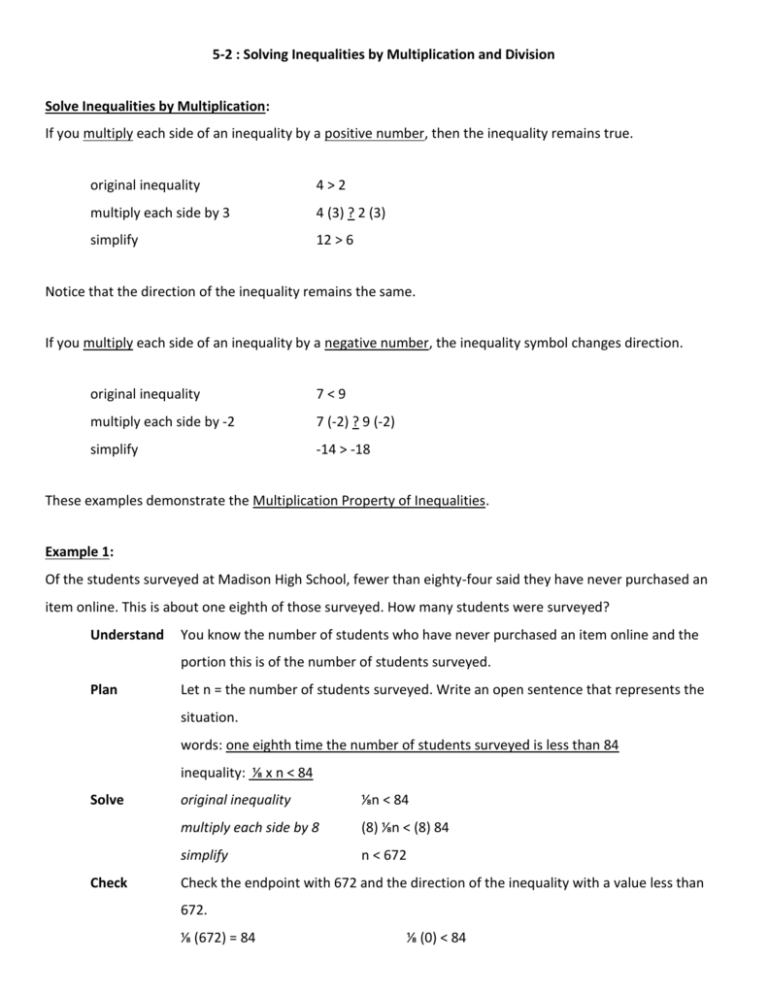
5-2 : Solving Inequalities by Multiplication and Division
Solve Inequalities by Multiplication:
If you multiply each side of an inequality by a positive number, then the inequality remains true.
original inequality
4>2
multiply each side by 3
4 (3) ? 2 (3)
simplify
12 > 6
Notice that the direction of the inequality remains the same.
If you multiply each side of an inequality by a negative number, the inequality symbol changes direction.
original inequality
7<9
multiply each side by -2
7 (-2) ? 9 (-2)
simplify
-14 > -18
These examples demonstrate the Multiplication Property of Inequalities.
Example 1:
Of the students surveyed at Madison High School, fewer than eighty-four said they have never purchased an
item online. This is about one eighth of those surveyed. How many students were surveyed?
Understand
You know the number of students who have never purchased an item online and the
portion this is of the number of students surveyed.
Plan
Let n = the number of students surveyed. Write an open sentence that represents the
situation.
words: one eighth time the number of students surveyed is less than 84
inequality: ⅛ x n < 84
Solve
Check
original inequality
⅛n < 84
multiply each side by 8
(8) ⅛n < (8) 84
simplify
n < 672
Check the endpoint with 672 and the direction of the inequality with a value less than
672.
⅛ (672) = 84
⅛ (0) < 84
84 = 84
0 < 84
The solution set is {n | n < 672}, so fewer than 672 students were surveyed.
Example 2:
3
Solve -7r < 21. Graph the solution on a number line.
3
-7r < 21
7
3
original inequality
7
7
(-3) (-7r) > (-3) 21
multiply each side by -3. Reverse the inequality symbol.
r > -49
simplify. Check by substituting values.
The solution set is {r | r> -49}.
On Your Own:
Solve each inequality. Check your solution.
𝑛
a. − 6 ≤8
b.
1
5
𝑚𝑚 ≥ −3
Solve Inequalities by Division:
If you divide each side of an inequality by a positive number, then the inequality remains true.
original inequality
-10 < -5
divide each side by -5
-10 / 5 ? -5 / 5
simplify
-2 < -1
Notice that the direction of the inequality remains the same.
If you divide each side of an inequality by a negative number, the inequality symbol changes direction.
original inequality
15 < 18
divide each side by -3
15 / -3 ? 18 / -3
simplify
-5 > -6
These examples demonstrate the Division Property of Inequalities.
Example 3:
Solve each inequality. Graph the solution on a number line.
a)
60t > 8
b)
60𝑚
−7𝑚
147
−7
−7
60
8
> 60
2
t > 15
-7d ≤ 147
≥
d ≥ -21
2
{𝑚𝑡 | 𝑚 > 15}
{d | d ≥ -21}
On Your Own:
c)
8p ≤ 58
d)
-42 ≥ 6r






